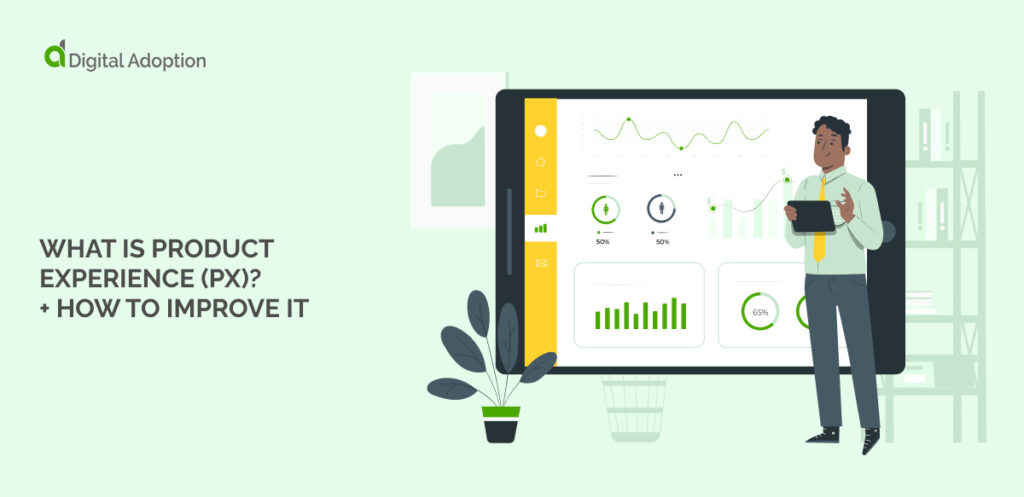Product experience (PX) refers to the feelings, emotions, perceptions, and interactions a user or customer has when engaging with a product’s features or functions.
It is a subset of the overall user experience and customer journey map that specifically occurs within the product. It includes aspects like product design, aesthetics, evoked emotions, and user behavior.
Ultimately, product experience significantly influences a customer’s purchase and usage behavior. Brands that prioritize the customer experience (CX) see a 60 percent increase in profits compared to those that neglect it, according to fresh data from the CX Index.
This article will explore the importance of product experience and how businesses can improve it to boost customer experience, loyalty, and revenue.
By the end of this article, you will have a better understanding of what product experience is, understanding its significance, and enhancing its value through effective measures, which we’ll walk you through.
What Is Product Experience?
Product Experience (PX) is a crucial aspect of the customer journey, encapsulating the perceptions, emotions, and interactions a customer has with a product.
This includes its design, functionality, usability, and the feelings it evokes. It extends from when a customer first encounters a product through its usage to any post-purchase interactions.
PX can significantly influence purchasing decisions, customer satisfaction, loyalty, and advocacy.
A positive product experience is achieved when a product fulfills its basic functions effectively and delivers added value and emotional resonance that exceeds customer expectations.
Product experience is ultimately about creating usable and meaningful products for the end-user.
Why Is Product Experience Important?
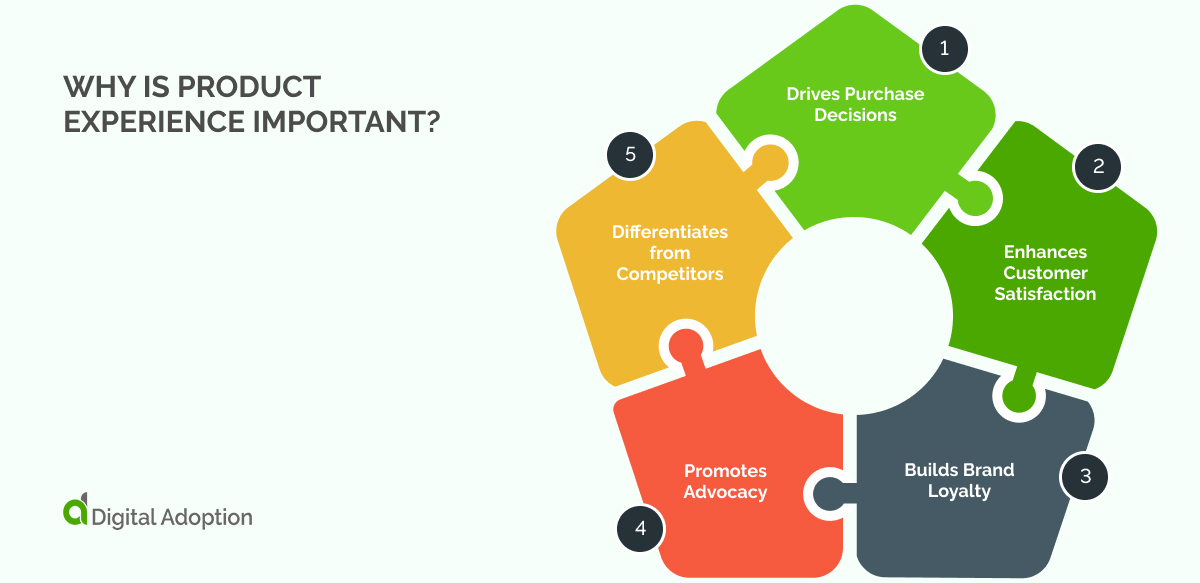
This section explores why Product Experience (PX) is crucial in shaping a brand’s success and how it influences various aspects of customer interaction and business growth.
The following are some of the key reasons why businesses should prioritize product experience:
Drives Purchase Decisions
Product experience is pivotal in influencing consumer behavior and guiding purchasing decisions. A product’s design, functionality, and overall experience can make it stand out in a market flooded with options.
A product that fulfills a customer’s needs and offers a smooth, enjoyable experience will likely be preferred over others. The user experience embedded within the product can often be the deciding factor for consumers when choosing between similar products.
Enhances Customer Satisfaction
A positive product experience significantly enhances overall customer satisfaction.
When users find that a product meets their functional requirements and provides a seamless and enjoyable experience, their satisfaction levels increase.
This satisfaction extends beyond just the product to the brand itself. A satisfying product experience is one where the product’s usability, aesthetics, and functionality exceed the customer’s expectations.
Builds Brand Loyalty
Brand loyalty is often rooted in consistent, positive product experiences.
When customers find a product they enjoy using that meets their needs and offers an experience that resonates with them, they will likely stick with that brand.
Over time, this loyalty can translate into repeat purchases, higher customer retention rates, and increased lifetime value for each customer.
Promotes Advocacy
A positive product experience isn’t just good for the customer—it’s also good for the brand.
Satisfied customers often become brand advocates, sharing their positive experiences with their network. This word-of-mouth marketing is incredibly valuable, as potential customers often trust the recommendations of their peers more than traditional advertising.
When brands concentrate on delivering an exceptional product experience, they can transform their customers into influential advocates.
Differentiates from Competitors
A superior product experience can be a key differentiator in a competitive marketplace. It allows a brand to stand out from competitors and carve its unique niche.
When brands prioritize product experience, they can carve out a unique selling proposition that distinguishes them from the crowd. The emphasis is not solely on the product’s function but also on the user’s feelings and the comprehensive experience it delivers.
Product Experience vs. User Experience vs. Customer Experience
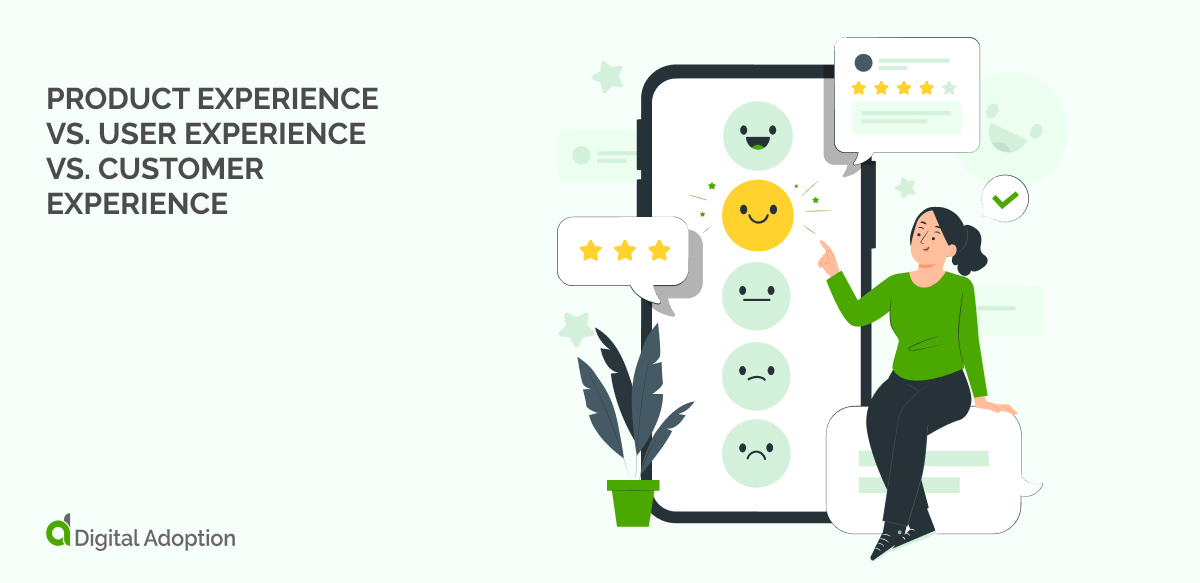
It is important to note that product experience (PX) is not the same as user experience (UX) or customer experience (CX).
While they are often used interchangeably, there are distinct differences between the two concepts.
Product Experience: Product experience refers to the customer’s interaction with a product, while UX encompasses all aspects of a user’s journey with a product or service. This includes interactions with the product, design, usability, and overall experience.
User Experience: User experience is a broader term that encompasses all interactions between a user and a company’s products or services. This includes interactions with the brand’s website, customer service, packaging, advertising, and other touchpoints throughout the customer journey.
Customer Experience: Customer experience is a customer’s overall impression and perception of a brand, encompassing all interactions and touchpoints with the company.
Product Experience Lifecycle Stages
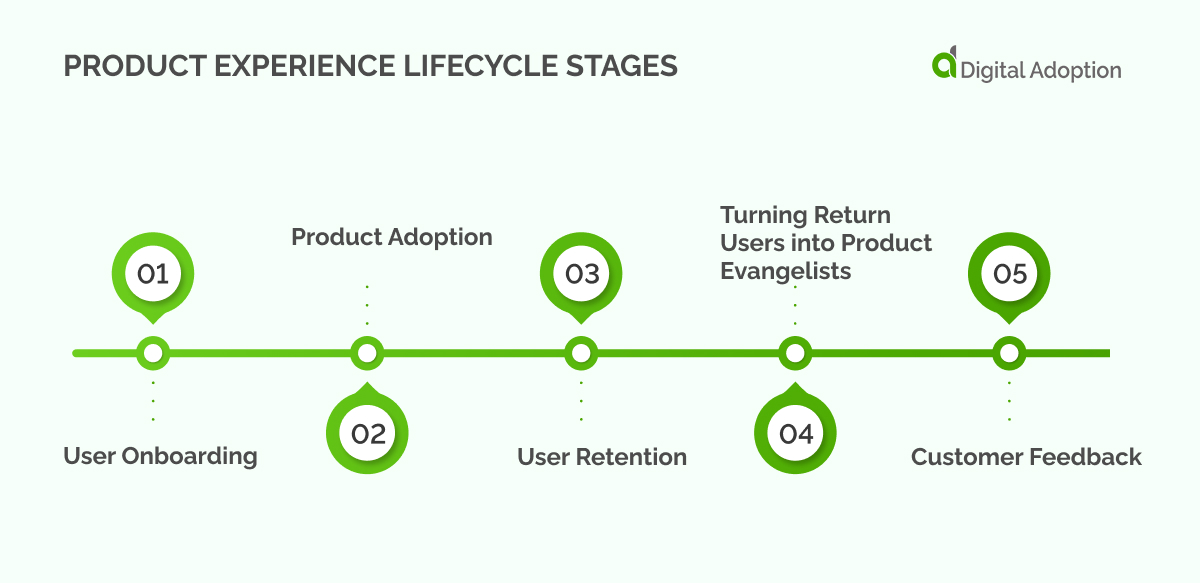
The lifecycle of product experience is typically divided into five stages: user onboarding, product adoption, user retention, turning return users into product evangelists, and customer feedback.
We’ve outlined each stage below to provide a better understanding of how product experience is built throughout the customer journey:
User Onboarding
This is the initial stage where new users are introduced to the product. A well-executed onboarding process can improve user understanding, reduce confusion, and set the foundation for a positive long-term relationship. It typically involves tutorials, walkthroughs, or guides that help new users navigate the product and understand its core features.
Product Adoption
After onboarding, the user starts to explore and use the product more extensively. Product adoption refers to how well users incorporate the product into their routines or workflows. The goal at this stage is to ensure that users see the value in the product and use it effectively and efficiently.
User Retention
Retention focuses on keeping users engaged with the product over time. This involves continuous product improvement based on user feedback and needs and offering support and resources to help users overcome any challenges they might face. High user retention indicates that the product meets its users’ needs over the long term.
Turning Return Users into Product Evangelists
This is a crucial stage where satisfied users become advocates for the product, promoting it within their networks. This can be achieved by creating a superior user experience that exceeds expectations or through incentives like referral programs. These evangelists can significantly increase the product’s visibility and credibility.
Customer Feedback
This stage involves gathering input from users about their experiences with the product. Feedback can be collected through surveys, user forums, social media, or direct communication. This valuable information can be used to identify areas for improvement, uncover new feature ideas, and ensure that the product continues to meet the evolving needs of its users. Customer feedback is an essential tool for continuous product enhancement and user satisfaction.
Who Owns Product Experience?
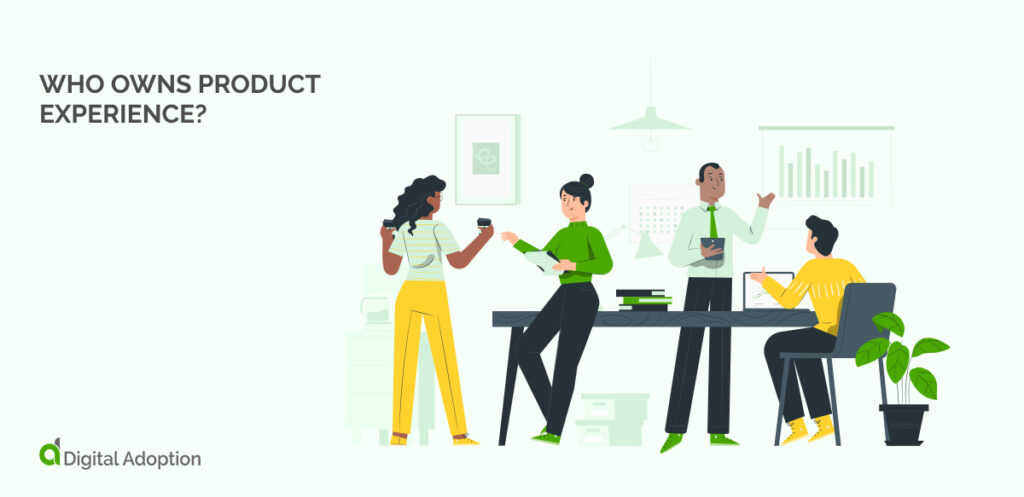
Product experience isn’t a task for one department alone.
It’s a collaborative effort involving product development, customer success, marketing, and sales teams. All these divisions must unite to understand customer expectations, develop the product accordingly, and effectively market it to achieve widespread adoption.
Product Development: This is where the product comes to life. It involves designing, creating, and refining products based on identified market needs and customer expectations. The goal is to build a seamless product that provides real value to the end-user.
Customer Success: This team ensures users get the most out of the product. Customer success provides support, resources, and training to help users overcome hurdles and optimize their product use. The aim is to promote user satisfaction and loyalty, which drives retention and growth.
Marketing: Marketing is about communicating the product’s value to potential customers. The marketing team works to attract, educate, and convert prospects through strategic campaigns, content creation, and social media engagement. Their goal is to generate awareness and interest, leading to increased adoption.
Sales: The sales team turns potential users into paying customers. They work to understand the needs and challenges of prospects and demonstrate how the product can provide solutions. The goal is to close deals, drive revenue, and contribute to business growth.
Product Experience Strategy
Should you wish to develop a product experience mechanism that nurtures users and boosts adoption, it’s imperative to devise a plan that embraces every phase of the product experience journey.
The following elements should be included in your product experience strategy:
Product and User Analytics
Product and user analytics are the backbone of any product experience strategy. They offer a clear picture of how users interact with your product – which features are popular, where users spend most of their time, and where they might face challenges.
By studying these analytics, you can pinpoint areas for enhancement and make evidence-based decisions for future product development.
Harnessing the Power of User Feedback
User feedback is an invaluable resource in shaping your product experience. It offers first-hand insights into what users love, what they don’t, and what they wish to see in your product.
Feedback can be gathered through various channels – surveys, reviews, or direct communication. Incorporating this feedback into your strategy ensures your product evolves with user expectations.
Boosting User Engagement
User engagement is a measure of how actively users are interacting with your product. High levels of digital engagement often signal that users find your product useful and enjoyable. Enhancing user engagement can be achieved by ensuring your product is easy-to-use, intuitive, and packed with the features users need.
Regularly communicating with users, such as through newsletters or update announcements, can also help maintain high levels of engagement.
The Art of Feature and Roadmap Prioritization
Feature and roadmap prioritization is a critical step in your product experience strategy. It involves deciding which new features or updates to focus on based on business objectives and user needs.
Prioritizing requires carefully balancing each feature or update’s potential impact, cost, and feasibility. Engaging users in this process, perhaps through feature voting systems, can ensure your product continues to evolve in line with user expectations.
8 Tips to Improve Your Product Experience
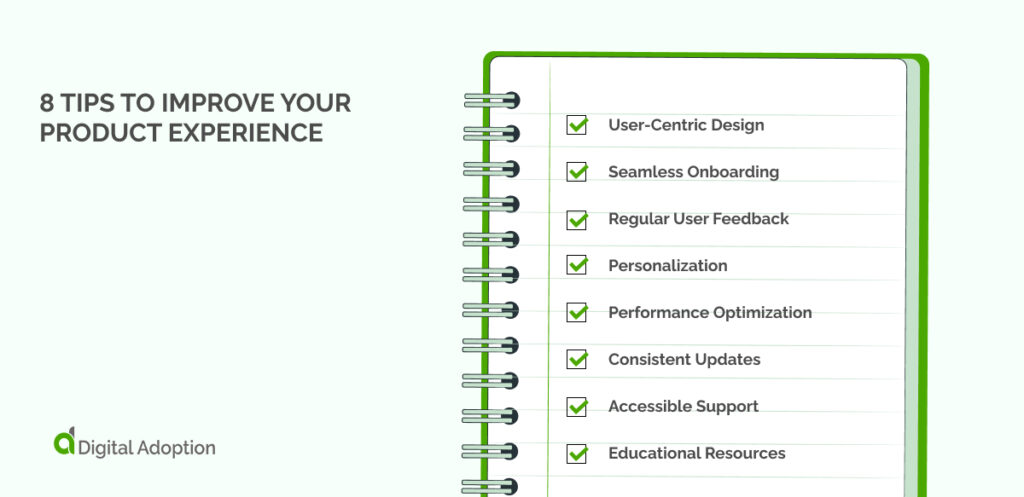
It’s no fun and games running a business with dissatisfied users.
To ensure your product experience meets user expectations, here are some tips to keep in mind:
User-Centric Design
A user-centric design approach is about understanding users’ needs, behaviors, and expectations. It involves researching and empathizing with your audience to create an intuitive product that meets their needs.
This could involve user interviews, surveys, or usability testing. By focusing on the user, you can build a functional, enjoyable, and easy-to-use product.
Seamless Onboarding
A user’s first interaction with your product can set the tone for their entire experience.
A well-designed onboarding process can guide users through initial setup, highlight key features, and provide helpful tips. This helps reduce any initial confusion, encourages proper use of the product, and can increase long-term user engagement and retention.
Regular User Feedback
User feedback is an essential tool for continuous improvement. It provides firsthand insights into what users like or dislike about your product and what future features they would like to see. This information can be collected through surveys, user interviews, or direct communication channels. Regularly soliciting and acting on user feedback shows users that their opinions matter and contribute to a better product experience.
Personalization
Personalization enhances the user experience by making it more relevant and engaging. It involves tailoring the product experience based on individual user behavior, preferences, or demographics. This could mean personalized content, recommendations, or interface settings. By making the product feel uniquely theirs, users will likely find more value and stay engaged longer.
Performance Optimization
Performance directly impacts the user experience. Users expect your product to work quickly, reliably, and without errors. Regular performance checks, stress tests, and optimizations ensure your product lives up to these expectations. A well-performing product reduces user frustration and increases satisfaction.
Consistent Updates
Regularly updating your product shows your commitment to improving the user experience and staying current with market trends. Updates could include new features, improvements to existing ones, or bug fixes. Besides improving the product, consistent updates give you regular opportunities to communicate with users and keep them engaged with your product.
Accessible Support
Providing accessible and effective customer support can greatly enhance the user experience. This means offering multiple channels for support (email, phone, live chat), providing fast and accurate responses, and treating users with respect and understanding. Good customer support solves user problems and builds trust and loyalty.
Educational Resources
Providing resources like tutorials, guides, FAQs, or webinars helps users get the most out of your product. These resources should be easy to find and understand. They empower users to solve issues independently and use your product more effectively, leading to a better overall product experience.
Leverage a No-Code Digital Adoption Platform to Effortlessly Create, Analyze, and Test Product
A digital adoption platform (DAP) is instrumental in enhancing product experience.
It effectively navigates users through your product by incorporating features such as walkthroughs and smart tips. This accelerates user onboarding and boosts software adoption rates, ensuring optimal utilization of your product.
A DAP is crucial in driving product-led growth by creating captivating in-app experiences. These tailored experiences have the potential to greatly enhance customer retention. DAPs also offer interactive learning opportunities to educate customers, thereby enriching their overall product experience.
Fundamentally, a DAP guarantees smooth user experiences, rendering it an invaluable tool for product creation, analysis, and testing.

 FACT CHECKED
FACT CHECKED